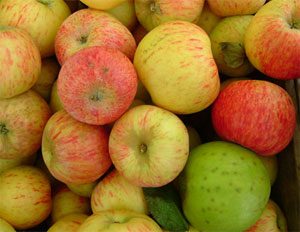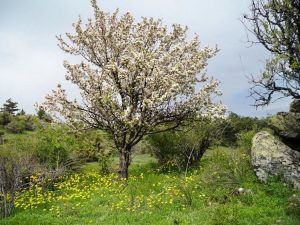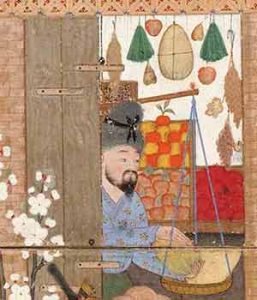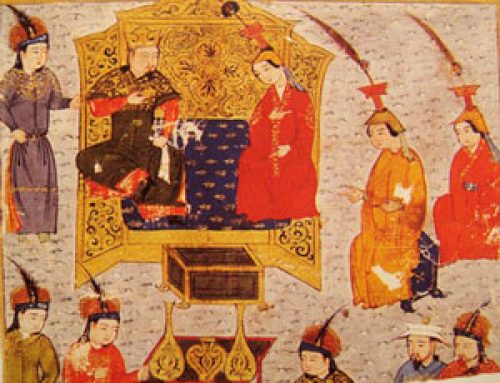
The history of apples starts in Central Asia
Where do apples come from?
Apple trees grew wild in Central Asia and western China beginning – as new DNA studies show – about ten to twenty million years ago, around the time that the first humans were evolving.
Central Asian food
All our Central Asia articles
That was the Tertiary Period. Apples are related to roses, berries, peaches, almonds, and many other fruiting plants.
What else was going on in the Tertiary?
Where do almonds come from?
Find out more about peaches

History of apples: this is the wild apple tree – Malus Sieversii – that is the ancestor of our apples.
When did apples get so good to eat?
Early apples were small and sour – more like crabapples. Birds ate their seeds. But then mammals like deer, pigs, and bears moved into Central Asia, about seven million years ago.
Some kinds of apples – – Malus sieversii – evolved to take advantage of this new way to spread their seeds. To get animals to eat them, these apples became bigger and sweeter. Apples evolved to have tear-drop shaped seeds that would pass right through the animal’s digestion.
Horses, which also lived on the steppes of Central Asia, were eating apples about five million years ago.
Where do pigs come from?
Where do horses come from?
Apples reach West Asia and China
When Homo Erectus arrived in Central Asia about a million years ago, they probably began to eat apples right away. That was in the Quaternary period.
What else was going on in the Quaternary?
More about early humans
Modern humans ate apples too, when they got to Central Asia, about 50,000 BC. By about 6,500 BC, people were carrying apple seeds west to West Asia and east to China, planting apple trees, and eating apples there too.
The Bible in English has Adam and Eve eating an apple, but actually in Hebrew it just says that they ate a fruit, and not what kind; the apple comes from a Latin translation.
What’s the story of Adam and Eve?

Shop with apples and other fruit on display. Mir Sayyid ‘Ali,”Nighttime in a Palace,” detail, Safavid or Mughal, ca. 1570 AD (now at Harvard)
Apples in Europe
Still, apples were among the first plants that people planted on purpose. By 2000 BC, people were eating apples in Greece and Italy, and by 1300 BC there were a few apple trees in Egypt.
What people ate in New Kingdom Egypt
Before the Romans came to England there were already apples there, too. People mostly don’t grow apples in Africa or south India, because it’s too close to the equator for apples to grow well. Apples need cold nights to ripen well.

Grinding apples and pressing cider (Vinetum Britannicum; London 1678)
Storing apples for winter
For ancient and medieval people, the best thing about apples was that they came ripe just as it was getting cold and they would keep all winter, so you could have food even when nothing was growing.
People sliced apples and dried them in the sun to make dried apples, and they stored them in underground cold bins just as whole apples, but mostly they pressed the apples with wooden presses to make cider.
Making apple cider
If you let the apple cider ferment with yeast, it becomes a slightly alcoholic drink, and the alcohol preserves the apple juice all winter. Apple cider was the main alcoholic drink of many people in northern Europe.
What people ate in Northern Europe
How does yeast fermentation work?
When the Spanish, and then the English, came to North America, they both brought apples with them in the 1600s AD, to make apple cider. All along the East Coast and in the Pacific Northwest, apple cider was again many people’s main drink until Prohibition put the cider orchards out of business in the 1920s.
What was Prohibition?
Did you find out what you wanted to know about the history of apples? Let us know in the comments!
Apple Project
More about Central Asian food
Bibliography and further reading about apples:
Food, by Fiona MacDonald and others (2001). For kids, facts about food from all over the world. A little preachy.
Food in Antiquity: A Survey of the Diet of Early Peoples, by Don and Patricia Brothwell (1998). Pretty specialized, but the book tells you where foods came from, and how they got to other places, and what people ate in antiquity. Not just Europe, either!
Food: A Culinary History from Antiquity to the Present, by Jean Louis Flandrin, Massimo Montanari, Albert Sonnenfeld. (1996). Hard going because it is translated from French, but Flandrin was one of the world’s great food historians.





This is a great article. I learned so much. Thanks for writing this!
Thank you, Debrin! It really makes my day to hear that! If you want to help keep this site going, you or someone you know could support us at https://www.patreon.com/quatr_us , or maybe link to us from your website or social media – that would be a big help!
It is not true that apples are not grown in India. Apples are grown alot in India in the Himalaya regions, and is a common fruit found in the fruit markets across India, especially in the North.
Sorry about that, Padmini! I added “south India” to make it right. Thanks for speaking up!
In the first paragraph, you contradict yourself. The first sentence states that “Apple trees grew wild in Central Asia and western China beginning possibly about two to ten million years ago,” but the last sentence states that “Horses, which also lived on the steppes of Central Asia, were eating apples five million years ago.” If horses were eating apples in Central Asia 5 million years ago, then the first sentence should state that apple trees “grew wild … beginning possibly about 5 million to ten million years ago,” not 2 to 10 million years ago.
Wow, thanks for pointing that out! I took a look and there’s been a lot of new research done on apple DNA since I wrote this article, so I updated the whole thing. I hope you’ll reread it now, because a lot has changed!
[…] Where do Apples Come From? […]